In the world of online advertising, display and social ads are the glamourous ones. They provide ample room for creativity with your copy and imagery, you can mix and match branding elements, and each ad has its own personality.
With search ads? Not so much.
There are no images to set the tone (image extensions don’t count), everyone gets the same 90 characters of blue text, and the words you use directly impact your Quality Score and Ad Rank. It can feel very cookie cutter…

But that doesn’t mean you can’t still find ways to be creative and differentiate yourself from other advertisers on the SERP. In fact, I’ve rounded up a batch of Google ads examples to prove just that. Read on to browse through search ads that stand out, from a wide range of industries, tones, and approaches, that you can use to get ideas for your own.
12 eye-catching Google Ads examples to model after
As you come up with ideas from these examples, you may start to get overwhelmed with how you can make it work using the responsive search ad format. Fret not. We have a responsive search ad copy template you can use.
1. The snappy specialist
When I searched the query “buy swing set,” I saw a number of ads that did all the right things—they used the word “best,” mentioned discounts, shared unique features. But this ad from King Swing Sets had me sold with its snappy “We Do Swing Sets, Nothing Else” headline. If this is all King does, then it must be pretty darn good at it. This is niche marketing at its finest.
I also like the conversational tone in the description (“We get it, it’s a big purchase”) is a great example to follow if you specialize in a specific niche.

2. The differentiator
The key ingredient in any good elevator pitch is your differentiator—what sets you apart from other providers of your product or service. This ad from Kustomer came up for the query “customer service software” and the headline reads “The Customer Service Platform – Based on Customers Not Tickets.”
The “this, not that” phrase can be a powerful way to distinguish your product or service from competitors. Then it has a nice supporting description that reads “A Customer-Centric Software For Immediate, In-Depth Responses To Customer Service Requests.”
Well done.
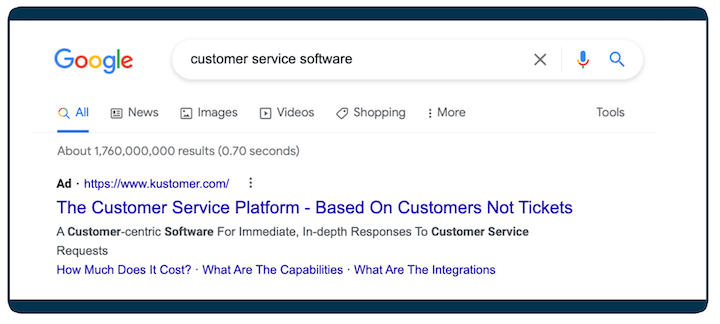
3. The feature drop
Another way to differentiate your business from surrounding ads is to mention a very specific feature. For example, for the same query above, there’s an ad by Zoho that reads “Best Customer Service Software – AI to Deduct User Sentiments.” Now that’s a unique selling point. It stands out to me. The ad could be even stronger if there was more about this feature in the description, but then again, my intrigue is driving me to click.
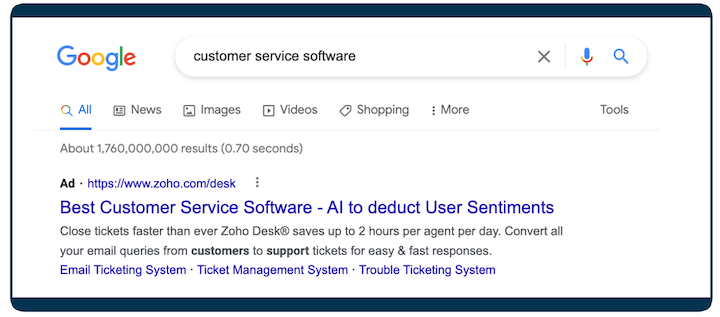
4. The benefit banker
On the other end of the spectrum, we have this Google ad example by Thesis that’s banking on benefits to drive clicks. The search query is “high quality energy supplements” and yet nothing in the headline mentions supplements or quality. It reads “Focus, Energy, Clarity – Hours of Focus, Zero Crash.” Then the description says “Finish your projects, accomplish your goals, and get. back to focused work.”
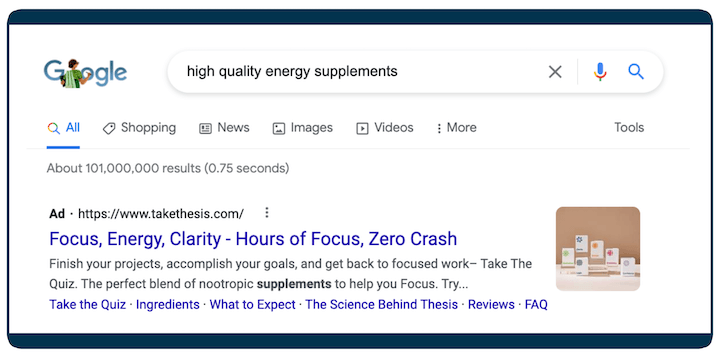
Looking for more ways to improve your Google Ads? Download our >> Hacking Google Ads
5. The qualifier
The Google ad below by BlueVine reads “Small Business Loans – Requires $100K + Annual Revenue.” That feels a little…restrictive right? But that’s the point. BlueVine doesn’t want to be paying for clicks or clogging up its CRM with leads that aren’t eligible for the type of loan it offers. This is a great way to pre-qualify your leads and avoid wasting Google Ads spend.
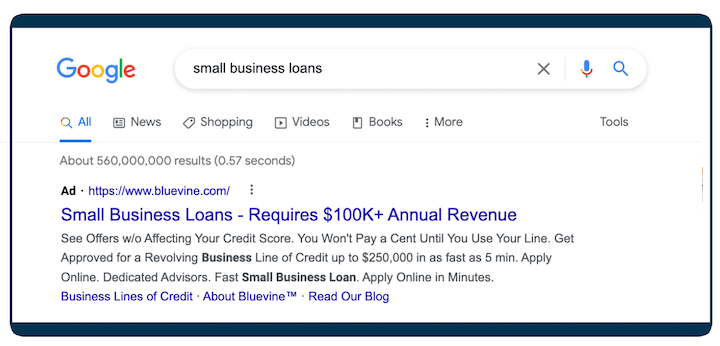
6. The alliterative artist
Sure, there are fancy copywriting formulas and techniques out there like bucket brigades and P-A-S (pain-agitate-solution), but there’s also P-S-A (plain and simple alliteration), and Fiverr’s Google ad below is a fine example of it.
It reads “Fiverr Freelance Services – Hire Pros for Your Projects.” Fiver, freelance, pros, projects—whether this was intended or not, it reads easy and even has an aesthetic feel to it. There’s even a “Whole World” alliteration in the description. I’ll take it.
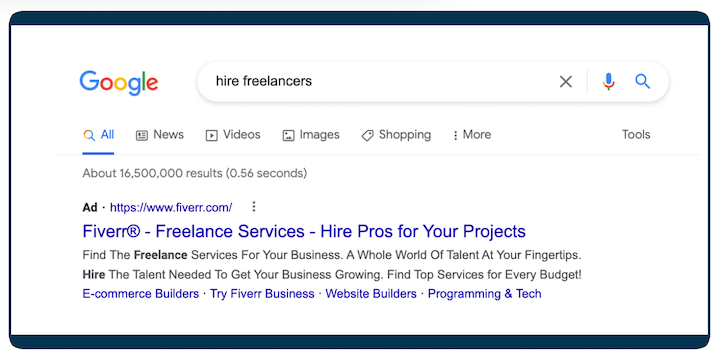
7. The scorekeeper
Copy that sells is clear, concise, compelling, and credible. The best way to be credible without being verbose? Nix the adjectives and replace with numbers. In the Thrive Market Google ad example below, we see lots of digits. They’re all….”We’re the #1 Organic Online Market, we offer 30% On Top Brands, we have 1 million members, and we offer 6,000+ products, but who’s counting, right?”
They are. And for good reason. That’s a lot of trust signals right there.
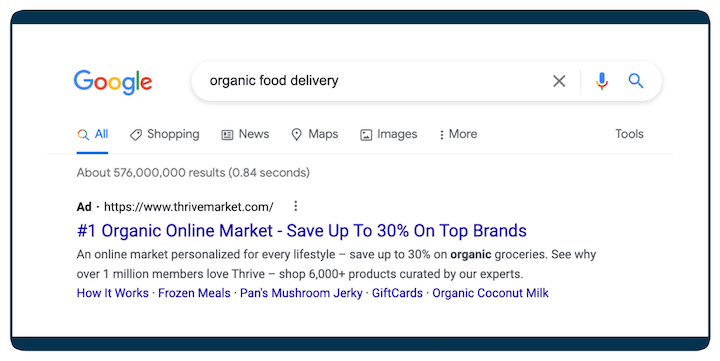
8. The conversationalist
Marketers spend all kinds of time thinking up the perfect, most engaging ad copy when really, the words we are drawn to are the ones we use ourselves. In other words, conversational is the new compelling. The ContentFly Google ad below is a great example. It reads “Top Copywriting Services – No Blogspam, No Keyword Fluff.”
As a content marketer and having been subject to blogspam and keyword fluff myself over the years, this copy is like music to my ears. Plus, the succinct description packs a punch: Great Content Isn’t a Luxury, It’s a Necessity. Request Content From the Top 1% of Writers. Nice work.
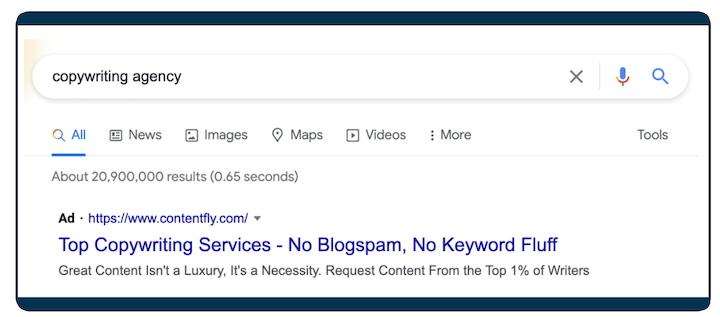
9. The speed demon
When I searched “fraud lawyer” on Google, I got a number of ads, most of which had long descriptions filled with features and benefits. That’s all well and good, but then there was this one from justanswer.com that said “Ask a Lawyer: Fraud – Lawyer Will Answer in Minutes.” Right off the bat, we get the speedy vibe here, and the quick, skimmable one-line description and review extension below it are like icing on the cake.
The easier a task or instruction is to read, the more believable and easy it is perceived to be. It’s cognitive fluency. It’s copywriting psychology.
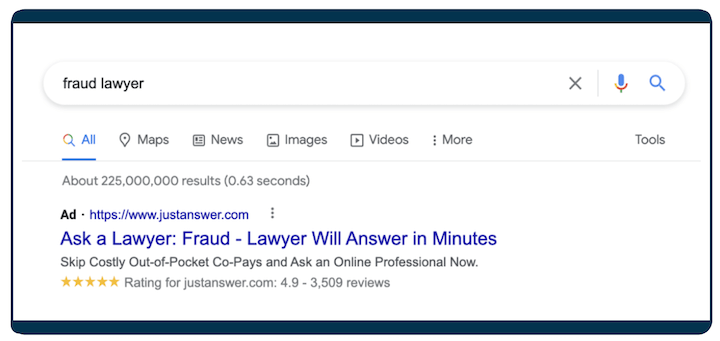
10. The pain point prodder
Remember earlier when I mentioned the P-A-S copywriting formula? You address the pain point, then you agitate it, then you offer the solution. Coordinate’s Google ad example below is perhaps the shortest version of this technique. The ad reads “No follow through?” (pain) – Are they dropping the ball?” (agitate), then in the description “Coordinate project management software can help” (solution).
And then one final little agitator with “Start holding customers accountable.” If that’s not marketing with emotion, then I don’t know what is.
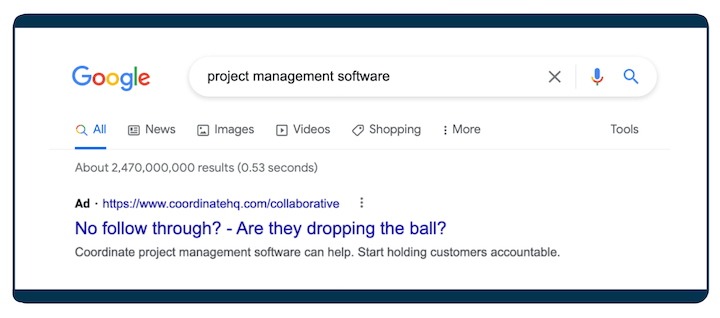
11. The trash talker
You know the commercials that say things like “Our toothpaste removes 25% more coffee stains than the leading provider”? And it’s basically their way of saying “Don’t use those guys, we’re better”? Well how about a Google ad that actually just says that.
In the Google ad example below, I searched “baker brothers” (an HVAC company) and you’ll notice the second ad down whose headline reads “Don’t Hire Those Guys, Really – We Can Beat Their Prices.” Indeed, this ad copy is actually most effective when the ad is not the #1 result. Quite clever.

You can find more competitive Google ad examples here.
12. The repetitive Randy (?)
Closest thing to Nancy. So the repetition in this Google ad example (“Don’t Overpay For Rackets – Avoid Paying Full Price”) could be for one of two reasons. Either it’s because of how responsive search ads work—Google mixes and matches headlines, which is why it’s important to make sure you have them set up so that all combinations work with one another.
Or, it’s intentional. Notice that this is not a tennis or sporting good brand. It’s a Capital One Shopping ad for its browser extension, so the point may be to drive home the affordability factor and attract people looking not for the best racket out there, but the best discount.
Either way, whatever message you’re trying to drive home, repetition is an effective copywriting technique to get it done.

Takeaway tips from these Google Ads examples
As you can see, even within the restrictions we have for search ads, there is still room to be creative and find ways to stand out on the SERP. Here are the key takeaways from these Google Ads examples that you can use to inspire your own:
- If you specialize in a particular niche, make it known and inspire confidence in your audience.
- Set your business apart with a “this, not that” phrase.
- Include a differentiating feature in your headline.
- Saturate your ad copy with benefits.
- Pre-qualify your leads by including price points or requirements.
- Give your ad copy a rhythm with alliteration.
- Use data (number of customers or reviews, average rating, options to choose from, etc.) as trust signals.
- Speak conversationally to your audience.
- Emphasize speed of service with ad copy that reads quickly.
- Try the pain-agitate-solution copywriting formula.
- Bid on your competitor’s brand names with outwardly competitive copy.
- Drive home a message with repetition.
The post 12 Eye-Catching Google Ads Examples & How to Copy Them appeared first on WordStream.

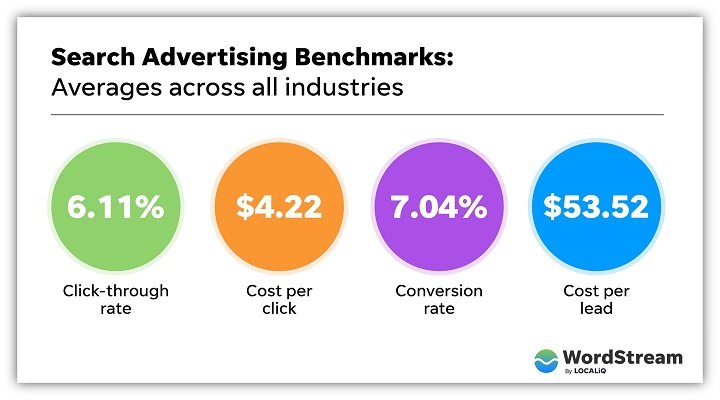


Recent Comments